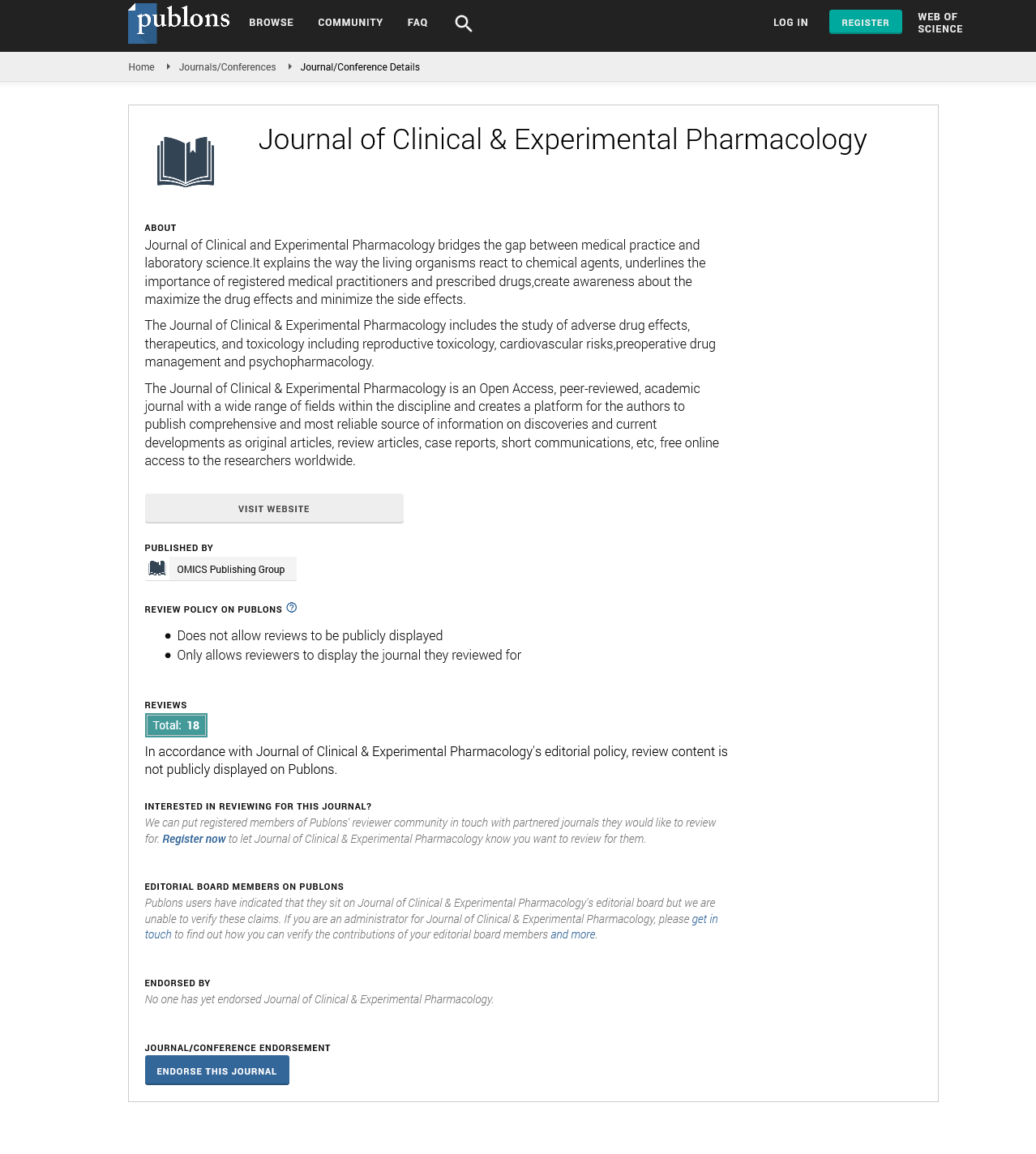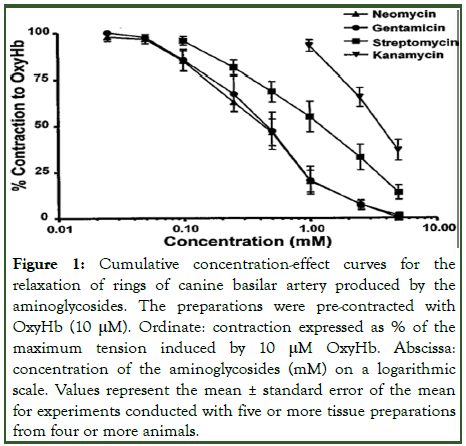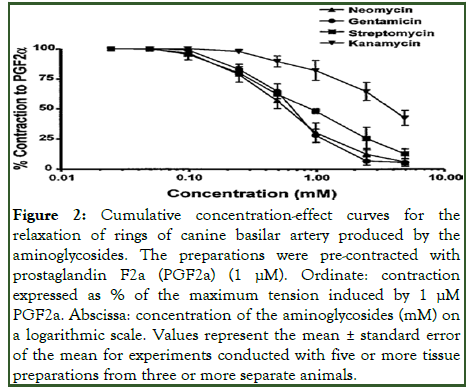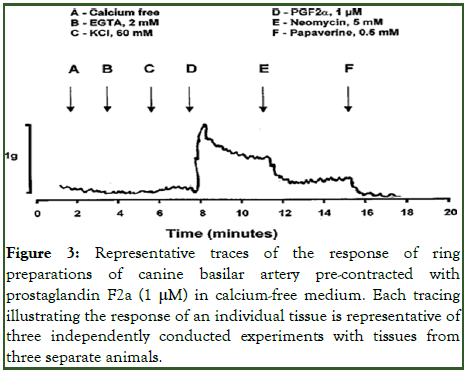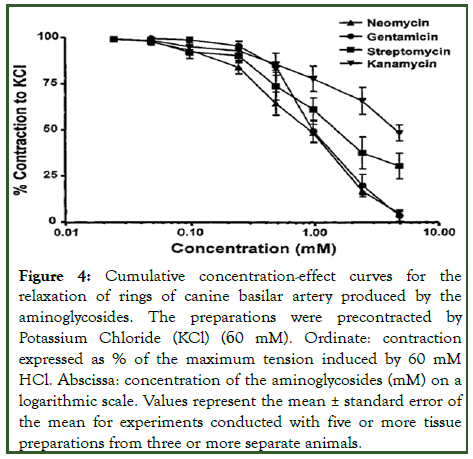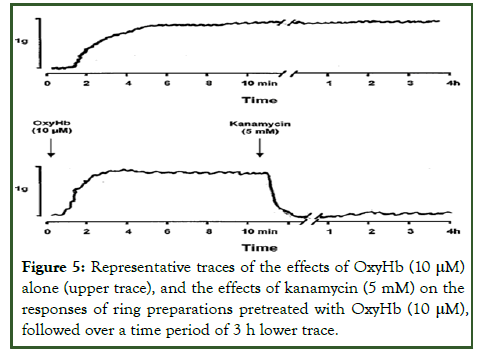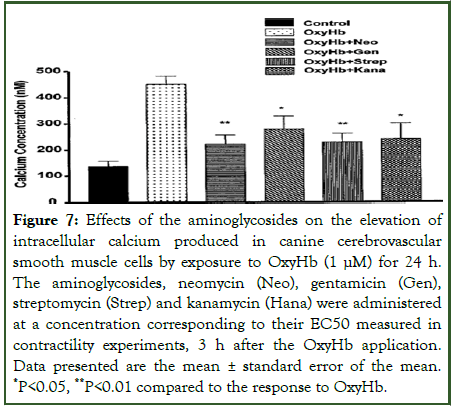Indexed In
- Open J Gate
- Genamics JournalSeek
- China National Knowledge Infrastructure (CNKI)
- Ulrich's Periodicals Directory
- RefSeek
- Hamdard University
- EBSCO A-Z
- OCLC- WorldCat
- Publons
- Google Scholar
Useful Links
Share This Page
Journal Flyer
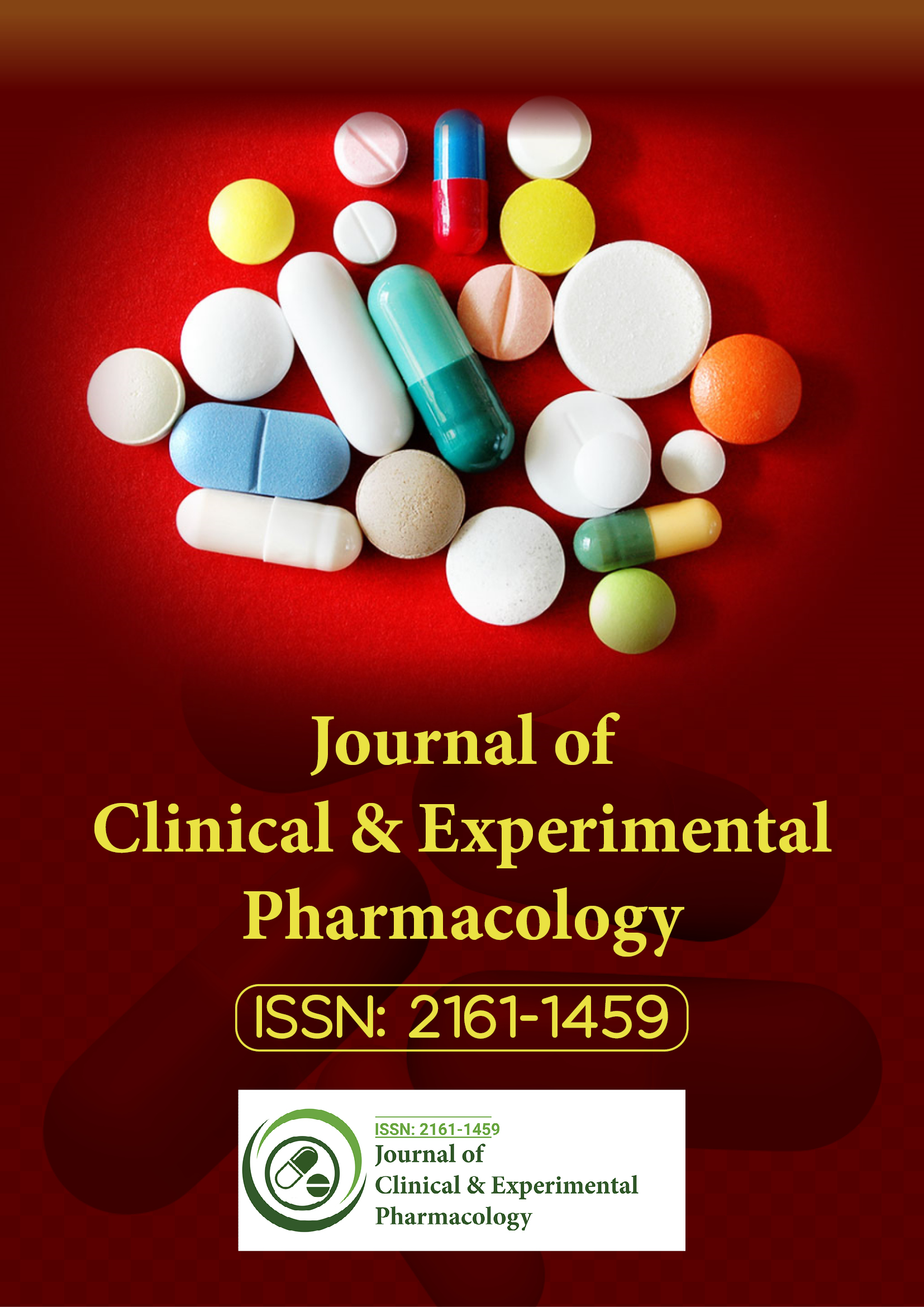
Open Access Journals
- Agri and Aquaculture
- Biochemistry
- Bioinformatics & Systems Biology
- Business & Management
- Chemistry
- Clinical Sciences
- Engineering
- Food & Nutrition
- General Science
- Genetics & Molecular Biology
- Immunology & Microbiology
- Medical Sciences
- Neuroscience & Psychology
- Nursing & Health Care
- Pharmaceutical Sciences
Research Article - (2025) Volume 15, Issue 1
Canine Cerebral Artery Vasodilation Caused by Aminoglycoside Antibiotics: The Mechanism
Hari Prasad Sonwani*Received: 15-Nov-2023, Manuscript No. CPECR-23-23917; Editor assigned: 18-Nov-2023, Pre QC No. CPECR-23-23917 (PQ); Reviewed: 04-Dec-2023, QC No. CPECR-23-23917; Revised: 03-Jan-2025, Manuscript No. CPECR-23-23917 (R); Published: 13-Jan-2025, DOI: 10.35248/2161-1459.25.15.460
Abstract
In canine cerebral arteries and in cultured cerebrovascular smooth muscle cells activated with Oxyhemoglobin (OxyHb), a blood component linked to the pathophysiology of cerebrovascular spasm, the effects of aminoglycoside antibiotics were investigated. The aminoglycosides reduced isometric tension in cerebral artery rings pre-contracted with OxyHb (10 μM) in a concentration-dependent manner. The relaxation's EC50 values for neomycin, gentamicin, streptomycin, and kanamycin were 0.4 ± 0.1 mM (n=α), 0.53 ± 0.08 mM (n=12), 1.α ± 0.3 mM (n=7), and 3.9 ± 0.5 mM (n=5), respectively. The quantity of positive charges in the molecules is roughly correlated with this potency ranking. Additionally, the contractions to prostaglandin F2a (1 μM) and depolarizing potassium chloride concentrations (α0 mM) were suppressed by the aminoglycosides. The potency was neomycin, gentamicin, streptomycin, and kanamycin in that sequence. The ease of mind persisted in prepared arteries devoid of endothelium. In response to PGF2a, neomycin (5 mM) eliminated the Ca2+-independent contraction. When Fura-2 was added to cerebrovascular smooth muscle cells, OxyHb (1 μM) markedly increased the intracellular calcium ((Ca2+)i) concentration by 330%. The administration of EC50-corresponding amounts of neomycin, gentamicin, kanamycin, and streptomycin decreased the effects of OxyHb on (Ca2+)i by approximately 50%, resulting in values of 221 ± 35 nM (n=7), 270 ± 31 nM (n=7), 229 ± 33 nM (n=α), and 240 ± α nM (n=5). These findings imply that the aminoglycosides' impacts on the OxyHb-induced contraction and the sustained rise in (Ca2+)i may stem from a variety of mechanisms, such as PLC inhibition, calcium extrusion mechanism protection, and interference with the (Ca2+)i accumulation process.
Keywords
Cerebrovascular spasm; Cerebral arteries; Oxyhemoglobin; Prostaglandin F2a; Aminoglycoside antibiotics; Intracellular calcium
Introduction
A prolonged constriction of the cerebral arteries known as cerebral vascular spasm occurs a few days following Subarachnoid Hemorrhage (SAH). In patients who have recovered from the initial hemorrhage, the condition is the primary cause of morbidity and mortality; yet, no medication has been proven to stop or reverse vasospasm once it has started. Oxyhaemoglobin (OxyHb) appears to be the causal element in this case, according to findings from our laboratory and other sources. The delayed arterial spasm is most likely the result of erythrocyte lysis in the clot, which releases OxyHb. In isolated vascular preparations, OxyHb is known to elicit prolonged smooth muscle contraction, and there is strong evidence that this process is what leads to the clinical state. Although it is difficult to refute OxyHb's role in the etiology of vasospasm, it is still unclear how this chemical causes vasospasm. According to one theory, the first stage in the development of vasospasm is the production of oxygen free radicals during the oxidation of OxyHb to methemoglobin and the lipid peroxidation that follows. It has been demonstrated that lipid peroxides and free radicals can activate a number of cellular activities, such as mitogen and the activation of phospholipases C, A2, and D as well as protein kinase C (PHC) [1]. Proto-oncogene expression and activated protein kinase (MAPH). Our findings indicate that OxyHb causes a brief rise in the synthesis of inositol (1,4,5) trisphosphate (Ins(1,4,5)P3) in vascular smooth muscle cells. This finding raises the possibility that PLC's hydrolysis of phosphatidylinositol (4,5) bis-phosphate is a precursor to the process. Additionally, we have demonstrated that OxyHb increases intracellular calcium ((Ca2+)i) with a time-course that resembles OxyHb's contractile activity, indicating that these processes may be functionally related. Neomycin is a nonselective inhibitor of Phospholipase C (PLC) and an aminoglycoside antibiotic for Gram-negative bacterial infections. It inhibits both the increase in Ins (1,4,5) P3 and the vasoconstriction caused by OxyHb. This substance attaches itself to inositol phospholipids, preventing the PLC's hydrolysis of these fats. Research on the role of this family of lipids in smooth muscle contraction and other cellular processes has been conducted extensively using neomycin and related aminoglycoside antibiotics. Aminoglycoside antibiotics have been demonstrated to inhibit PHC, transmembrane calcium channels, and calcium release from the sarcoplasmic reticulum of skeletal muscle, in addition to their impact on inositol phospholipids. transporter. This last finding raises the possibility that mechanisms other than those connected to the inositide pathway may be responsible for the aminoglycosides' inhibitory effect on smooth muscle contraction. The myocardial, autonomic ganglia, kidney, and neuromuscular junction are among the organs and tissues where the aminoglycoside antibiotics are calcium antagonists. Additionally, the outcomes of human clinical trials and in vivo investigations employing a primate model of cerebral vasospasm revealed that the aminoglycoside antibiotic kanamycin had some positive effects in angiographic spasm. The molecular processes underlying the pathophysiology of vasospasm were not well understood at the time; the testing of kanamycin was conducted based on a notion that was quickly disproved, hence these reports have gone mostly unreported. These findings point to the potential efficacy of neomycin and related aminoglycosides in blocking the cellular mechanisms assumed to be involved in the etiology of cerebral vasospasm. Therefore, we have looked into how neomycin and other structurally comparable aminoglycosides affect the vasoconstriction that OxyHb causes in the cerebral arteries of dogs. The effects of aminoglycoside antibiotics on intracellular calcium levels have also been evaluated in cerebrovascular smooth muscle cells treated with OxyHb, due to the critical role that changes in intracellular calcium levels play in the development of vasospasm [2].
Materials and Methods
Techniques
Capturing isometric tension data: Any gender mongrel dogs up to twenty kilograms in weight were applied in their research. All experiments adhered to the Declaration of Helsinki's and the University of Alberta's Animal and Ethics review Committee's authorized protocols for the humane treatment of animals. The Cerebral arteries were removed from the brain and placed in an oxygenated Hrebs-Henseleit solution containing the following components (in mM): Na+ 130, H+ 5, Ca2+ 2.5, Mg2+ 1.2, Cl- 12.2, HCO3- 25, SO42- 1.2, H2PO42- 1.2, and dextrose 11. The animals were then killed by intravenous (i.v.) overdose of pentobarbitone. Cutting the middle segment of the basilar artery into sections about 3 mm long, the preparations were hung in tissue baths containing Hrebs-Henseleit solution either intact or with the endothelium physically removed. Gassed with 95% O2 and 5% CO2 at 37°C. For one hour, the artery rings were at equilibrium. Using a Grass 7D polygraph and force-displacement transducers, contractions to OxyHb were recorded isometrically [3]. A contraction induced by OxyHb peaked at 100% at various intervals between 4 and 15 minutes after the drug was initially given. The relaxant responses to bradykinin in preparations precontracted with 1 µM Prostaglandin F2a (PGF2a) were used to assess the presence of an intact endothelium in an arterial ring preparation. After the endothelium was removed from basilar arteries, rings were obtained and pre-constricted with high amounts of potassium chloride (a0 mM), OxyHb (10 µM), or PGF2a (1 µM). After that, the preparations were shown to the Aminoglycoside antibiotics were given to preparations where a tonic constriction to OxyHb had formed at progressively higher cumulative concentrations (0.0-5 mM). The reactions were recorded for a minimum of three hours in order to ascertain if the relaxation brought about by the aminoglycosides was permanent or only momentary. The percentage of maximum relaxation induced by 0.5 mM papaverine chloride was utilized to express the relaxation of the preparations subjected to aminoglycoside antibiotics. Using a nonlinear regression analysis, the aminoglycoside antibiotics' EC50 values were found [4].
Culture of cerebral vascular smooth muscle cells: The method previously outlined for the preparation of cells. In summary, basilar arteries were isolated using the above-described sterile procedures, and the central segments of the arteries were put in a Petri dish with Dulbecco's Modified Medium Eagle (DMEM). The vessels were divided into segments that were around 5 mm long along the longitudinal axis, the adventitia was mechanically removed, and the endothelium was removed by gently scraping the inner surface of the segments. Following tissue chopping into 1-2 mm pieces, the explants were placed in 25 cm2 culture flasks supplemented with 1 ml of DMEM containing 10% foetal calf serum, 100 µg of streptomycin, and 100 u ml-1. Following the adhesion of the explants, the culture media was replaced once a week and the volume was progressively increased over the course of the following four days to 4 ml each flask. The cerebrovascular smooth muscle cells were transplanted to 75 cm2 flasks when the primary cultures were about confluent and subsequently regularly sub-cultured at a 1:3 split ratio [5].
Measurement of intracellular free calcium ion: As previously mentioned, the fluorescent indicator Fura-2 was used to measure the intracellular calcium concentration in suspensions of smooth muscle cells. To put it briefly, the process of intracellular loading Fura-2 involved culturing the cerebrovascular smooth muscle cells of dogs or monkeys for 45 minutes at 37°C in a modified Hrebs-Henseleit buffer that contained 5 µM of Fura-2 AM, the acetoxymethylester of Fura-2. After two rounds of washing, the loaded cells were resuspended at a density of roughly 10 ± cells ml-1. Using a Perkin-Elmer MHF-4 spectrofluorimeter, measurements were taken. At 340 and 380 nm for excitation and 380 nm for emission, fluorescence was detected nm=505. The intracellular calcium ((Ca2+)i) was calculated and the resulting signal was calibrated using the Grynkiewicz, et al. method, wherein Rmin and Rmax were ascertained by treating the cells with Triton X-100 (0.1%) in the presence of 5 mM EGTA and 5 mM calcium chloride, respectively. These investigations were carried out on vehicle-treated control cells as well as those that were exposed to OxyHb and the aminoglycosides for a whole day. In order to more closely mimic the clinical scenario, in which therapeutic agents would be given some time after vasospasm had developed, the aminoglycosides were added to the cells three hours after OxyHb was added, at a concentration equal to the EC50 values found from the contractility studies [6].
Substances and additional agents: Sigma provided the human hemoglobin (Hb), PGF2a, and sulphate salts of gentamicin, kanamycin, streptomycin, and neomycin. When sodium sulphate (15 mM) was employed as a vehicle control for the aminoglycosides, it was discovered that both the fluorescence and the muscular tension were unaffected in proportion. The procedure described by Martin, et al. was followed in order to prepare OxyHb from human Hb. Using absorption spectrophotometry, the concentration of OxyHb was ascertained. The best grade commercial products were used for other chemicals.
Statistical evaluation of the outcomes: The standard error of the mean, plus the number of preparations utilized, are given as the mean ± the mean. Once significant probability was attained, the Tukey-Hramer multiple comparison test was used to determine statistical significance. One-way Analysis of Variance (ANOVA) was used for this purpose. Significant values were defined as P<0.05.
Results
Impact of aminoglycoside antibiotics on contractions brought on by KCl, PGF2a, and OxyHb A slow-developing, prolonged contraction was elicited by a single dose of 10 μM OxyHb. Total neomycin concentrations eliminated contraction (100% relaxation, n=α), whereas streptomycin and gentamicin, given at the same concentrations, had the greatest relaxing effects (9 ± .8 ± 1.8α%; n=12) and (8α.15% ± 3%; n=7), respectively. The least effective agent was hanamycin, which resulted in a maximal relaxation of ± 3.4 ± 5. ± 1% (n=5). Figure 1 presents these findings. The EC50 values for several aminoglycosides against OxyHb-induced contractions. The aminoglycosides were neomycin (0.4 ± 0.1 mM), gentamicin (0.53 ± 0.08 mM), streptomycin (1.α ± 0.29 mM), and kanamycin (3.88 ± 0.4α mM) in that order of potency [7].
Figure 1: Cumulative concentration-effect curves for the relaxation of rings of canine basilar artery produced by the aminoglycosides. The preparations were pre-contracted with OxyHb (10 μM). Ordinate: contraction expressed as % of the maximum tension induced by 10 μM OxyHb. Abscissa: concentration of the aminoglycosides (mM) on a logarithmic scale. Values represent the mean ± standard error of the mean for experiments conducted with five or more tissue preparations from four or more animals.
The contraction induced by PGF2a, an agonist whose actions are mediated by G-protein coupled receptors, was likewise effectively inhibited by the aminoglycosides. Figure 2 displays the cumulative concentration-effect curves for gentamicin, streptomycin, neomycin, and gentamicin. The cerebral artery preparations' contractile responses compared to OxyHb, happened more quickly with a maximum occurring at around 30 seconds for PGF2a. Neomycin, gentamicin, streptomycin, and kanamycin had maximum relaxations of 9α.α ± 3.1% (n=α), 94.1 ± 2.5% (n=7), 84.7 ± α% (n=3), and 59.4 ± 0.21% (n=4), in that order. The EC50 values for various aminoglycosides, which correspond to the potency order seen when OxyHb was used to induce contractions. When the contractile responses to PGF2a were produced in a Ca2+-free medium, the relaxing effects of the aminoglycosides persisted, indicating that the action of the aminoglycosides is, at least partially, mediated by the inhibition of PLC activity. In these studies, Ca2+-free Hrebs-Henseleit buffer was used in place of the standard Hrebs-Henseleit medium after the basilar artery preparations had been equilibrated in it. EGTA at 2 mM. PGF2a caused these preparations to constrict, whereas HCl had no effect on them. That response was significantly reduced by neomycin, and it was further reduced by papaverine. Figure 3 displays representative traces of the effects of neomycin as a relaxant and PGF2a [8].
Figure 2: Cumulative concentration-effect curves for the relaxation of rings of canine basilar artery produced by the aminoglycosides. The preparations were pre-contracted with prostaglandin F2a (PGF2a) (1 μM). Ordinate: contraction expressed as % of the maximum tension induced by 1 μM PGF2a. Abscissa: concentration of the aminoglycosides (mM) on a logarithmic scale. Values represent the mean ± standard error of the mean for experiments conducted with five or more tissue preparations from three or more separate animals.
Figure 3: Representative traces of the response of ring preparations of canine basilar artery pre-contracted with prostaglandin F2a (1 μM) in calcium-free medium. Each tracing illustrating the response of an individual tissue is representative of three independently conducted experiments with tissues from three separate animals.
Every aminoglycoside under investigation resulted in the contractions induced by α0 mM potassium chloride concentrations relaxing, indicating that these agents not only inhibit PLC activity but also calcium influx via voltage-dependent calcium channels activated by depolarizing HCl concentrations. Neomycin, gentamicin, streptomycin, and kanamycin had maximal relaxant effects on HCl-mediated vasoconstrictions of 95. ± 1.3% (n=5), 9α.8 ± 3.2% (n=4), α9.8% ± α.9 (n=5), and 52.8% (n=5), respectively (Figure 4). The EC50 for these agents [9].
Figure 4: Cumulative concentration-effect curves for the relaxation of rings of canine basilar artery produced by the aminoglycosides. The preparations were precontracted by Potassium Chloride (KCl) (б0 mM). Ordinate: contraction expressed as % of the maximum tension induced by 60 mM HCl. Abscissa: concentration of the aminoglycosides (mM) on a logarithmic scale. Values represent the mean ± standard error of the mean for experiments conducted with five or more tissue preparations from three or more separate animals.
Time course of the aminoglycosides' vasorelaxant effects The ability of the aminoglycosides to create long-lasting vasodilation may be crucial because human experience with the reversal of vasospasm has demonstrated that certain medications, such papaverine, can relax spastic arteries. For therapeutic purposes, the response is too fleeting. This aminoglycoside was utilized in the current study because kanamycin has been demonstrated to be useful in the reversal of angiographic spasm in the monkey model of vasospasm. Representative traces of the effects of kanamycin on the canine basilar artery for a minimum of three hours are displayed in Figure 5. Comparable findings were seen with the other aminoglycosides' temporal course. Throughout the duration of the studies, there is no relaxation of the persistent contraction to OxyHb (Figure 1). The degree of relaxation remained constant after three hours, a fact that could have significant therapeutic ramifications [10].
Figure 5: Representative traces of the effects of OxyHb (10 μM) alone (upper trace), and the effects of kanamycin (5 mM) on the responses of ring preparations pretreated with OxyHb (10 μM), followed over a time period of 3 h lower trace.
Vascular endothelium's impact on vasodilation caused via aminoglycosides We examined the effects of neomycin on the OxyHb-induced vascular tension in the isolated basilar artery, both in the presence and absence of endothelium, to ascertain if the efficiency of the aminoglycosides could result from an impact mediated by the endothelium. Bradykinin responses were used to measure the degree of endothelium preservation; in preparations with intact endothelium, the chemical acts as a vasorelaxant, but in preparations lacking endothelium, it acts as a vasoconstrictor. Representative responses to bradykinin from canine arterial rings pre-constricted with OxyHb (10 μM) or PGF2a (1 μM) are displayed in Figure 3. Bradykinin did not have a relaxing impact on the preparations where endothelium had been eliminated, but instead caused a contraction at greater dosages, whereas the complete activity of neomycin was retained (Figure 6) [11].
Figure 6: Representative traces of the effects of bradykinin on rings of canine basilar artery from which the endothelium had been mechanically removed. The rings were pre-contracted with OxyHb (10 μM) (upper trace) or prostaglandin F2a (1 μM)(lower trace). Bradykinin produces no relaxation, and at higher doses produces a contraction, suggesting that the endothelium has been removed from the preparations. The relaxation of neomycin is unimpaired. Each trace, which illustrates the response of an individual ring preparation, is representative of three independent experiments conducted with preparations from three different animals.
Following a 24-hour exposure to OxyHb (1 μM), the cells were treated with aminoglycosides, neomycin, gentamicin, kanamycin, and streptomycin at concentrations that matched the EC50 found
in the contractility assays three hours later. Figure 7 illustrates how OxyHb significantly raised intracellular calcium levels from control values of 135.8 ± 21 nM to 450 ± 31.8 nM (n=8). These increased calcium levels were reduced by approximately 50% upon administration of neomycin, gentamicin, kanamycin, or streptomycin, to 221 ± 35.α nM (n=7), 279.2 ± 31.3 nM (n=7), 229.1 ± 33.8 nM (n=α), and 240 ± 59.8 nM (n=5), respectively. This observation is consistent with the outcomes of experiments where contractility was measured [12].
Figure 7: Effects of the aminoglycosides on the elevation of intracellular calcium produced in canine cerebrovascular smooth muscle cells by exposure to OxyHb (1 μM) for 24 h. The aminoglycosides, neomycin (Neo), gentamicin (Gen), streptomycin (Strep) and kanamycin (Hana) were administered at a concentration corresponding to their EC50 measured in contractility experiments, 3 h after the OxyHb application. Data presented are the mean ± standard error of the mean. *P<0.05, **P<0.01 compared to the response to OxyHb.
Discussion
These investigations have demonstrated that OxyHb, a component linked to the etiology of cerebral Vasospasm caused a prolonged vasoconstriction of cerebral artery preparations, which the aminoglycoside antibiotics gentamicin, kanamycin, streptomycin, and neomycin were able to reverse. Our research also showed that potassium chloride concentrations that depolarize cerebral artery preparations preconstricted with PGF2a might be relaxed by the aminoglycoside antibiotics [13-15]. Neomycin and gentamicin were the most potent vasorelaxants, but streptomycin and kanamycin were less successful. With six, five, four, and two amino groups, respectively, these compounds vary in their chemical makeup and the quantity of positive charges they contain. Consequently, it appears that the quantity of amino groups influences the inhibitory effects of each specific aminoglycoside, at least in part. This observation aligns with the findings presented here on the inhibitory effect. Effects the aminoglycosides on the sustained increase in intracellular calcium in cerebrovascular smooth muscle cells that have been grown. Since the aminoglycosides' chemical makeup makes it improbable that they will pass through the cell membrane, their effects are most likely the result of interactions with anionic elements of the cell surface. The capacity of aminoglycosides to inhibit PLC-mediated hydrolysis of inositol phospholipids and so prevent the following increase of (Ca2+)i, which is implicated in smooth muscle contraction, makes them an immediate contender for the mechanism by which they produce blood vessel relaxation. It is widely acknowledged that an increase in (Ca2+), which comes from smooth muscle's sarcoplasmic reticulum mobilizing calcium, causes calcium to bind to calmodulin and subsequently activate light-chain kinase (MLCH) of myosin. Muscle contraction is caused by the phosphorylation of myosin light chains by MLCH, which also activates myosin ATP-ase activity and myosin-actin interaction. Therefore, blocking PLC with amino acids would stop the mobilization of (Ca2+)i caused by Ins (1,4,5) P3, which would stop the contraction. It has been demonstrated that OxyHb increases Ins (1, 4, 5) P3 as well as (Ca2+)i in cerebrovascular smooth muscle cells. The exact mechanism underlying this effect is still unknown, although it most likely involves the activation of PLC by free radicals. Neomycin has the ability to reverse the rise of Ins (1, 4, 5)P3 caused by OxyHb, as demonstrated earlier [16]. This finding implies that OxyHb's contractile action may be mediated, at least in part, by partially, through PLC. The idea that the aminoglycosides partially owe their action to PLC inhibition is supported by our observation that the aminoglycosides block prostaglandin F2a's action in the absence of exogenous calcium. The effects of PGF2a are mediated by receptors coupled to a Gq protein, and hence to an elevation of Ins(1,4,5)P3 mediated by PLCß. The process also involves a PLC-mediated increase in Ins(1,4,5)P3 and an elevation of (Ca2+)i as described above. This process is independent of the presence of extracellular calcium. Later in the development of the response, this initial elevation of (Ca2+)i may activate a receptor or second messenger-operated Ca channel, but the initial response is maintained in a Calcium-free medium, and that response is inhibited by the aminoglycosides. The mechanism involving an increase in levels of Ins (1,4,5) P3 can account for only part of the action of the aminoglycosides; the elevation of Ins (1,4,5) P3 is transient and it is unlikely that the sustained response to OxyHb, which corresponds to a large and sustained increase in (Ca2+)i, arises from activation of PLC alone [17]. The studies reported here show that the sustained elevation of (Ca2+)i produced by OxyHb can be reversed by the aminoglycosides, when they are administered after the concentration of Ins (1,4,5) P3 has returned to the control level. This clearly suggests that other sites of action should be considered, a view which is further supported by the observation that all aminoglycosides used in these studies inhibited vasoconstriction to depolarizing concentrations of potassium chloride, which cause contraction by increasing calcium influx through L-type voltage-dependent calcium channels, a process which is independent of the activation of PLC [18]. Since molecular events leading to uptake and binding of Ca2+ are thought to involve association of Ca2+ with anionic binding sites localized in calcium channel subunits, it is conceivable that the availability of channel anionic sites may be decreased by polycationic organic bases such as the aminoglycosides, thus resulting in the inhibition of calcium entry. On the other hand, calcium influx through channels of this type does not seem to play a major role in cerebral vasospasm or in OxyHb-mediated vasoconstriction, since antagonists of L-type channels are rather poor antagonists of both processes. Nimodipine was originally recommended for the clinical management of vasospasm because it was believed that it would relax the constricted blood vessels; it now appears most likely that the benefit of nimodipine in severe vasospasm arises from a neuroprotective effect on ischaemic regions thus limiting the size of the infarct. Significant vasodilation during clinical vasospasm has been difficult to demonstrate, and although the issue remains controversial, nimodipine in our hands is not very effective at reversing the OxyHb-induced contraction of isolated arterial segments. Neomycin and the other aminoglycosides are much more effective in reversing OxyHb-induced contractions than the L-type calcium channel antagonists, and there are a variety of possible explanations for this. First, neomycin is a known inhibitor of L-type calcium channels, but has also been reported to inhibit a variety of ion channels in addition to the L-type, including N-, and ‘non-L/non-N‘-type voltage sensitive calcium channels. The exact nature of the mechanism by which cells treated with OxyHb accumulate calcium is not known, however, and electrophysiological studies in freshly dissociated cells revealed a calcium influx in response to OxyHb which had few characteristics of known calcium transport mechanisms. It is also possible that the lesion lies not in an acceleration of calcium influx, but an inhibition of calcium efflux, a suggestion for which there is some experimental evidence [19]. The plasma membrane Ca2+ pump can be damaged by the action of free radicals, and this protein is the preferred substrate for the proteolytic action of calpain, a protease activated by high levels of (Ca2+)i. It is conceivable that aminoglycosides have some protective effects on this process, possibly by forming a ternary complex with iron and the phospholipid polar head, which may decrease Fe2+ oxidation and thus inhibit the production of oxygen free radicals, as has been observed for endogenous polyamines. Another possibility for the action of the aminoglycosides involves an endothelium-mediated relaxation. The haeme moiety of OxyHb molecule is known to bind nitric oxide, a diffusable vasodilator synthesized from arginine in endothelial cells; OxyHb would thus prevent the relaxant effect of nitric oxide in vascular smooth muscle. It has been suggested that this mechanism might, in part, explain the vasoconstriction observed with OxyHb [20].
Conclusion
In the present studies, we have shown that removal of the endothelium prevented bradykinin-mediated vasodilation, but did not affect the vasorelaxant action of the aminoglycosides. This explanation thus seems unlikely. It is possible that the unexpected effectiveness of the aminoglycosides in preventing the action of OxyHb, arises from a multiplicity of actions. If they inhibit the action of PGF2a by acting as inhibitors of phospholipase C, and they block potassium by interfering with calcium influx, it is possible that both effects come into play in the case of OxyHb. There is reason to believe that the initial and the sustained contractions observed with OxyHb are not independent processes; it may be that the sustained calcium entry is triggered by the early elevation in Ins (1, 4, 5) P3, and if this is true, the combination of two separate mechanisms may account for the high effectiveness of this group of compounds. Currently the only clinical data is for kanamycin, a compound which was shown to be effective in whole animal models and in patients about two decades ago. In our studies this was actually the least effective aminoglycoside, and thus studies in whole animal models of vasospasm with more potent aminoglycosides or other polycationic compounds are well worth undertaking. It is unlikely that i.v. administration of these drugs would provide access to the spastic vessels in suAcient concentration to provide effective relaxation, since the drugs would not be expected to cross the blood-brain barrier. On the other hand, intracranial application of a sustained release preparation during surgery for clipping of the aneurysm, remains a realistic possibility.
References
- Abate C, Patel L, Rauscher III FJ, Curran T. Redox regulation of fos and jun DNA-binding activity in vitro. Science. 1990; 249(4973):1157-1161.
[Crossref] [Google Scholar] [PubMed]
- Adams HR, Goodman FR, Weiss GB. Alteration of contractile function and calcium ion movements in vascular smooth muscle by gentamicin and other aminoglycoside antibiotics. Antimicrob Agents Chemother. 1974;5(6):640-646.
[Crossref] [Google Scholar] [PubMed]
- Berridge MJ. Inositol trisphosphate and calcium signalling. Nature. 1993; 361(6410):315-325.
[Crossref] [Google Scholar] [PubMed]
- Catterall WA, Striessnig J. Receptor sites for Ca2+ channel antagonists. Trends Pharmacol Sci. 1992;13:256-262.
[Crossref] [Google Scholar] [PubMed]
- Cockcroft S, Gomperts BD. Role of guanine nucleotide binding protein in the activation of polyphosphoinositide phosphodiesterase. Nature. 1985; 314(6011):534-536.
[Crossref] [Google Scholar] [PubMed]
- Fasolato C, Innocenti B, Pozzan T. Receptor-activated Ca2+ influx: how many mechanisms for how many channels?. Trends Pharmacologicol Sci. 1994; 15(3):77-83.
[Crossref] [Google Scholar] [PubMed]
- Godicke J, Jacobsen L, Lullmann H, Mulder G. The polycationic compound gentamicin inhibits the calcium paradox in guineaâ?pig hearts. Acta Physiol Scand. 1992; 144(3):349-354.
[Crossref] [Google Scholar] [PubMed]
- Guyton KZ, Liu Y, Gorospe M, Xu Q, Holbrook NJ. Activation of mitogen-activated protein kinase by H2O2: role in cell survival following oxidant injury. J Biol Chem. 1996;271(8):4138-4142.
[Crossref] [Google Scholar] [PubMed]
- Harada T, Suzuki Y, Satoh SI, Ikegaki I, Asano T, Shibuya M, et al. Blood component induction of cerebral vasospasm. Neurosurgery. 1990; 27(2):252-256.
[Crossref] [Google Scholar] [PubMed]
- Kassell NF, Helm G, Simmons N, Phillips CD, Cail WS. Treatment of cerebral vasospasm with intra-arterial papaverine. J Neurosurg. 1992; 77(6):848-852.
[Crossref] [Google Scholar] [PubMed]
- Keith RA, Mangano TJ, DeFeo PA, Horn MB, Salama AI. Actions of neomycin on neuronal L-, N-, and non-L/non-N-type voltage-sensitive calcium channel responses. J Mol Neurosci. 1992;3:147-154.
[Crossref] [Google Scholar] [PubMed]
- Krueger C, Weir B, Nosko M, Cook D, Norris S. Nimodipine and chronic vasospasm in monkeys: Part 2 Pharmacological studies of vessels in spasm. Neurosurgery. 1985; 16(2):137-140.
[Crossref] [Google Scholar] [PubMed]
- Langton PD, Farley R, Everitt DE. Neomycin inhibits K+-induced force and Ca2+ channel current in rat arterial smooth muscle. Pflügers Arch. 1996; 433:188-193.
[Crossref] [Google Scholar] [PubMed]
- Macdonald RL, Weir BK, Runzer TD, Grace MG, Findlay JM, Saito K, et al. Etiology of cerebral vasospasm in primates. J Neurosurg. 1991; 75(3):415-424.
[Crossref] [Google Scholar] [PubMed]
- Miao FJ, Lee TJ. VIP-ergic and cholinergic innervations in internal carotid arteries of the cat and rat. J Cardiovasc Pharmacol. 1991; 18(3):369-378.
[Crossref] [Google Scholar] [PubMed]
- Pichler M, Wang Z, Grabner-Weiss C, Reimer D, Hering S, Grabner M, et al. Block of P/Q-type calcium channels by therapeutic concentrations of aminoglycoside antibiotics. Biochemistry. 1996;35(46):14659-14664.
[Crossref] [Google Scholar] [PubMed]
- Prentki M, Deeney JT, Matschinsky FM, Joseph SK. Neomycin: a specific drug to study the inositol-phospholipid signalling system?. FEBS lett. 1986;197(1-2):285-288.
[Crossref] [Google Scholar] [PubMed]
- Rohn TT, Hinds TR, Vincenzi FF. Inhibition of Ca2+-pump ATPase and the Na+/K+-pump ATPase by iron-generated free radicals: Protection by 6, 7-dimethyl-2, 4-di-1-pyrrolidinyl-7h-pyrrolo [2,3-d] pyrimidine sulfate (U-89843D), a potent, novel, antioxidant/free radical scavenger. Biochem Pharmacol. 1996;51(4):471-476.
[Crossref] [Google Scholar] [PubMed]
- Salamino F, Sparatore B, Melloni E, Michetti M, Viotti PL, Pontremoli S, et al. The plasma membrane calcium pump is the preferred calpain substrate within the erythrocyte. Cell Calcium. 1994; 15(1):28-35.
[Crossref] [Google Scholar] [PubMed]
- Smith WL. The eicosanoids and their biochemical mechanisms of action. Biochem J. 1989;259(2):315.
[Crossref] [Google Scholar] [PubMed]
Citation: Sonwani HP (2025) Canine Cerebral Artery Vasodilation Caused by Aminoglycoside Antibiotics: The Mechanism. J Clin Exp Pharmacol. 15:460.
Copyright: © 2025 Sonwani HP. This is an open-access article distributed under the terms of the Creative Commons Attribution License, which permits unrestricted use, distribution, and reproduction in any medium, provided the original author and source are credited.
